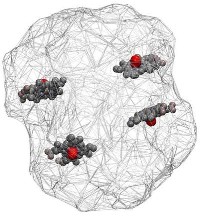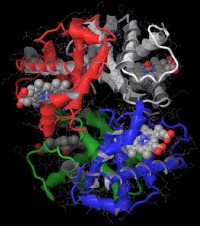|
Related Topics: |
|
|
|
Current News |
|
Chemistry A to Z |
|
About Internetchemistry |
Hemoglobin uncovered |
|
The transport of oxygen in blood is undertaken by hemoglobin, the largest component of red blood cells. This protein collects oxygen in respiratory organs, mainly in the lungs, and releases it in tissues in order to generate the energy necessary for cell survival. Hemoglobin is one of the most refined proteins because its evolution and small mutations in its structure can produce anaemia and other severe pathologies. |
|
The investigation led by V�ctor Guallar, ICREA researcher with the Life Sciences department of the Barcelona Supecomputing Center (BSC) and group leader of the Joint Computational Biology Programme between the Institute for Research in Biomedicine (IRB Barcelona) and the BSC, has allowed the definition at atomic level of the mechanism that regulates the exchange of lung oxygen to hemoglobin and from hemoglobin to tissue. The results of this study are published in the journal Proceedings of the National Academy of Sciences. More than a hundred years of study have led to the knowledge that hemoglobin uses mechanisms of cooperativity to optimize its function; that is to say, to collect the greatest amount of oxygen possible in the lungs and release it in tissues. These mechanisms of cooperativity are related to changes in the structure of the hemoglobin protein. However, due to the complexity of the system, until now it has not been possible to determine the microscopic mechanisms that guide this process. Consequently, this lack of information has been a serious limitation in drug design and the development of artificial forms that are more effective than the protein. V�ctor Guallar explains that "this study has provided detailed knowledge of the mechanisms that regulate the affinity of hemoglobin, which is crucial to understand, for example, the effects caused by mutations on its structure. Thus, we have obtained basic data on the relation between mutation and disease, which will allow the development of more specific treatments". Using sophisticated atomic calculation techniques, which combine quantum and classical mechanics, Guallar�s team has determined how, against what was commonly accepted, the affinity for oxygen appears to be controlled by interactions that are relatively distant from the active centre of the protein and that are directly involved in the structural changes responsible for cooperativity. Ra�l Alcantara, first author of the study and a member of Guallar�s group points out that "having access to the enormous calculation capacity of the MaresNostrum supercomputer allows more precise simulations, which are closer to what happens in real life". The results of this study open up vast possibilities for the engineering of this crucial protein. Having identified the factors that regulate the affinity of hemoglobin, alterations of its structure can now be designed. Likewise, the microscopic knowledge about the mechanisms of action of haemoglobin will improve our understanding of the effects of diverse mutations of this protein. |
|
|
|


